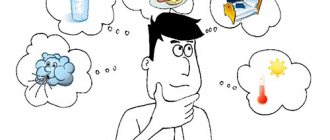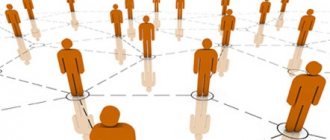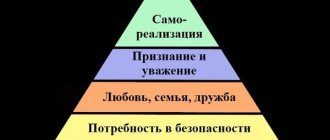Save article:
The article explains:
- The essence of Maslow's concept of needs
- Maslow's principles characterizing human nature
- Highest human needs
- Practical application of Maslow's theory of needs
- Criticism of Maslow's concept of needs
Maslow's needs are the most famous theory of motivation that probably everyone has heard of. The famous pyramid, where needs are in hierarchical order, has become the basis for practical application in various fields and for the construction of new theories. But is it relevant now, or is this theory only in textbooks?
Despite the fact that a number of provisions of Maslow’s theory have been criticized, the approach can still be used both in business and for career or self-development purposes. In our article we will tell you how to apply Maslow’s conclusions in practice, and also analyze his concept as a whole, its strengths and weaknesses.
What are needs
The key word in defining the concept of need is “need”.
Need
- this is the need for certain things, objects of the material world, objects, people, social indicators, in the absence of which a person feels uncomfortable.
Taking into account this definition, neediness, in order to become a need, must meet the following criteria:
- A lack of need causes a feeling of dissatisfaction. A need is something desired, a good.
- Accompanying with emotions: from negative at the first stage to joyful after the need is fulfilled. When we really want something, we get nervous and anxious; when we get what we want, we relax.
- Fixation on the subject of need. Consciousness snatches from reality those things that can satisfy us. For example, if we are hungry, we will focus on the food and the smell of food.
The system of needs is also formed according to special rules:
- Need is common to all living beings on the planet. But the more developed the species, the higher the level of needs. The tree has enough nutrients from the soil, sunlight, and rain watering. Man, as a highly developed animal, needs much more.
- The older the person, the more extensive the list of what is required. A baby can do without things that an adult needs.
- Needs are a strictly hierarchical structure, some are primary, others are secondary.
People's actions are dictated by the presence of a certain need, which is the main motivator of activity. Motivation to get what you want moves a person forward and forces him to act. Everything that has been created by people throughout the history of mankind in politics, economics, art, science is the result of activities to satisfy needs.
The inability to fulfill needs can lead to dependence on their importance for the individual and to the following various consequences:
- Physical death of a person
. If the need for food, sleep, water, air, safety, etc. is not satisfied. - Frustration
is a long-term experience associated with a nervous disorder and can lead to serious psychological problems. An example is the lack of recognition of a person’s merits by society. - Sublimation
- the transition of the energy of dissatisfaction into creation, creativity. For example, the absence of sex is replaced by heavy sports activities.
Thus, needs should be listened to and efforts should be made to realize them.
Concept
What are human social needs?
Social needs are desires that arise in a person during his life in society and interaction with other people.
Social needs are secondary to primary biological or physiological (food, water, sleep, rest), existential needs (safety, comfort). Primary needs, innate.
They arise in a person regardless of his presence in society. A person cannot exist without water, without food, etc. Secondary needs, which include social needs, arise directly in the process of living in society , that is, they are acquired.
Social dissatisfaction, unlike biological problems, cannot lead to the death of an individual, but can significantly reduce the level of his psychological health and complicate socialization.
Also, the lack of opportunity to satisfy social needs. needs can lead to a significant decrease in a person’s quality of life , and this, in turn, sometimes leads to a limitation of options for satisfying primary biological, existential needs.
For example, an unfulfilled social need for work can lead to a loss of a sense of security.
How to create a family genogram? Find out about this from our article.
What needs does a person have?
Man is one of the representatives of the animal world, with instincts and needs inherent in other species. At the same time, we have higher intelligence, feelings, and strong-willed qualities. This combination causes the presence of needs at two levels: basic and additional (primary and secondary).
Basic Needs
This group is vital for humans as a biological species. Basic needs are divided into two groups.
| Physiological | Existential |
| Breathing, nutrition, thirst, sleep, rest, procreation, housing. | Comfort, social and legal security, availability of employment, etc. |
Physiological basic needs must be satisfied first, since without them existence itself is impossible. The listed things and phenomena have been inherent in man since primitive times.
A person tries to make the process of satisfying basic needs more comfortable. If at the initial stage of the development of the human race animal skins served as clothing, today a whole industry is working to clothe us.
Basic needs can change with age in favor of the predominance of some over others. Sleep, for example, is more important for young children and older people, but in our youth we are able to get by with minimal hours of rest and still feel alert. Sex, as a primary need, can also, for a number of reasons, lose priority with age, but in adolescence it is a priority.
Questions often arise about security as a necessity for existence. Man has always experienced danger from phenomena in the surrounding world or from other people. A tsunami, a collapse of glaciers, an attack by wild animals or other tribes - all this forced a person to defend himself or run away. Over time, entire institutions were formed that were supposed to protect the individual from external incursions (army, police, Ministry of Emergency Situations). That is why safety is a primary need; we must understand that our lives and property are protected and protected.
The needs of existence (existence) appear as an individual grows up and determines his place in society.
Secondary needs
If a group of primary needs is necessary for survival and is laid down at the genetic level, then secondary needs determine a certain level of a person’s quality of life and come and are transformed with life experience.
Among the secondary needs in theory, the following are identified:
- Spiritual
. These include the need to obtain new knowledge about the world, the search for the meaning of life and one’s place in it, the development of creative abilities, and the desire for harmony. - Social
– love, friendship, interaction with other people, feeling part of society, a separate social group (class, work team, family). - Prestigious
. We are talking about the need for recognition of our successes, worthy self-esteem, respect from other members of the communities in which we belong.
Thus, primary needs are innate and determined by physiology, while secondary needs are psychological in nature and develop throughout life.
Examples of social needs
In order to better understand what the social needs of an individual are, you need to understand them using examples. In social science, this important topic for life is studied in detail as well as its manifestations.
- In development. The discoveries of mankind at the initial stage were tied to satisfying the needs for clothing, tools, and household utensils. But there were also researchers who sought discoveries in science in order to become famous.
- In public order. Any politician hopes to gain public approval in the same way as a volunteer, organizer of public events or other active citizen. At the same time, there is no place for cold calculations in the minds of the latter: caring for people occurs at the behest of the heart.
Businessmen can also take part in satisfying the social needs of the individual: the owner of a bakery will make it a rule to give free bread to the poor and elderly.
Types of needs
Needs can be classified on various grounds, of which there are quite a lot in the theory of psychology. The main types of division of needs are presented in the next section.
If we summarize all available theories, then we should distinguish three basic types of human needs.
Biological or physiological
Among the innate human needs laid down at the genetic level are the following:
- Food safety and taste characteristics.
- Comfortable external temperature and electromagnetic background.
- Clean water suitable for quenching thirst.
- Healthy ecology.
- Safety of life and home.
- Sexual satisfaction.
- Disposal of waste products.
These things are necessary for any living creature. This set of needs has practically not changed since the creation of the world, since from a physiological point of view, we are the same as millions of years ago. A person strives to realize them first and foremost and immediately.
Spiritual
Existential needs come from a system of universal human spiritual values, including: beauty, mercy, tranquility, harmony, peace, art. Each person has their own spiritual needs (as opposed to biological ones) and change over time and experience.
Among the spiritual needs are the following:
- The need for knowledge
. A mature person understands that in order to further grow, he must constantly learn. Moreover, expand the boundaries of existing skills and acquire new ones. People enter educational institutions to receive additional education, take advanced training courses, master new professions, and master the basics of painting and music. - The need for constant work on oneself, improving one’s personality (self-improvement)
. By satisfying this need, we quit smoking, go on a diet, get rid of toxic people and harmful emotions. A person thinks about how he would like to see himself after a certain period of time and strives for this. - The need for love and personal happiness
. The vast majority of people dream of having a loved one of the opposite sex nearby and creating a stable family. Many have been searching for many years, this need is so strong.
The realization of spiritual needs can be carried out through the simplest things. For example, a person goes into nature and sits with a fishing rod, fishing. At this time, he reflects, calms down, acquires spiritual harmony, satisfying his need for peace and making plans for the future.
Social
This type of needs is aimed at understanding one’s place in society and is associated with groups of people, social and economic activity.
Examples of social needs:
- Personal identification
. A person positions himself as a part of society with common traits inherent in society or a separate group. At the same time, he recognizes himself as an individual unit with a set of specific qualities and characteristics. - Self-affirmation
. We want to be satisfied with ourselves, with the actions and deeds that we perform. It is also important for a person to feel significant in society, to enjoy respect and approval from other people.
- Altruistic aspirations
. The individual takes pride in actions aimed at helping and assisting other people or living beings. He needs to be needed, useful, even in conditions of abandoning his own interests.
All of these types of needs are interpenetrating, they complement each other, some follow from others. For example, having satisfied the spiritual need to acquire a profession, we strive to achieve success in work for which we will be praised, and this is already a social need.
Characteristics of needs
Needs have a number of characteristics and are subject to certain laws:
- At birth, a person is characterized only by physiological needs, the rest develop later.
- The lower needs are characteristic of all people equally.
- The higher ones differ greatly from person to person and form an individual portrait of the individual.
- Satisfaction of lower needs opens the possibility for the formation of higher ones, but does not guarantee it.
- The higher the need, the less important it is for survival and the longer it may remain unsatisfied.
- The more a person is involved in various activities, the more complex his system of needs.
- Suppression has a negative impact on psychological and physiological well-being and deforms the personality.
- The occurrence and satisfaction are associated with various emotions.
- A person's focus is fixed on the subject of need and causes attention to flow in its direction.
More than 100 cool lessons, tests and exercises for brain development
Start developing
Classifications of needs
Theoretical psychology offers many classifications of needs. We have already discussed one of them above: physiological, social and spiritual, these are the main groups of needs.
Foreign researchers did not so much classify needs as offer a specific list of them.
Examples:
- G. Murray
- achievements, aggression, independence, sex, creativity, understanding, respect, self-knowledge. - A. Pieron
- novelty, hedonism, communication, competition, mutual assistance and others (more than 20 types in total); - E. Fromm
- significance, self-affirmation, communication, affection, self-identification.
Some scientists have identified so-called neurotic needs as a separate group, the lack of satisfaction of which can lead to mental illness. These include: lack of social and interpersonal justice, the need for support and empathy, recognition, and possession.
In Russia, a classification of needs has been adopted, which divides them into the following levels:
- Based on the nature of the emergence of needs - natural and cultural
. - Depending on the area of application - communicative
(communication with other people),
cognitive
(the need to acquire new knowledge),
labor needs
, etc. - In relation to the object to which the need is directed - biological, material, spiritual and social
. - Correlating to their origin - endogenous
(determined by internal factors) and
exogenous
(depending on external conditions).
As we see, the number of human needs is numerous; today there is no complete list of them; there are only generalized groups and types. The most famous theory that places all types of human needs in order of priority is Abraham Maslow's Hierarchy of Needs.
The psychologist drew a whole pyramid, where needs are indicated in ascending order. This is what she looks like.
Maslow assured that until a person has satisfied the needs of the widest part of the pyramid, he will not strive to receive benefits from the higher levels. For example, if a person is hungry, then he has no time for public recognition. He considered hunger not only in relation to food, but also to sleep, thirst, sex, etc.
Maslow’s rule does not work in the opposite direction: an individual who has fulfilled the need for respect and recognition still needs food and sleep.
Practical application of Maslow's theory of needs
Where and how is Maslow's theory of needs applied? In fact, psychological theory is applicable to many issues related to or based on human needs and motivation. It is implemented in marketing, management, psychology, in the process of self-analysis, for example.
- Marketing
In the process of promoting a product, a marketer needs to analyze the product being sold, determine its central audience and, in turn, study it. The next step is to figure out how to present the product to this buyer. At most stages, understanding a person's needs can be key. Both the needs themselves and the mechanisms and nature of human motivation allow us to form an idea of the needs and goals of people, as well as how to convince them to purchase a product.
Practical application of Maslow's theory of needsExamples can be given regarding different levels of needs. Basic needs - food and water - are realized in advertising of available products or establishments, when the emphasis is on nutrition and price. In premium product marketing, the analysis clearly addresses recognition needs, and so on.
Moreover, Maslow's theory allows you to plan a change in thinking and, accordingly, the goals and needs of the audience that remains with the brand. The mechanism and nature of needs, as well as the distribution in the hierarchy itself, is an excellent tool for analyzing the needs of the audience and the dynamics of their change over a certain period of time.
However, it is necessary to understand that using Maslow’s theory as the only tool is pointless. A good marketer uses a range of methods and resources, and Maslow's theory of needs is only one of them, although quite useful in certain conditions.
- Management
A manager interested in high productivity indicators of his employees must understand what and how motivates employees. Some managers use only economic incentives, while the theory of an American psychologist can be a very useful tool for analyzing audiences. Understanding the nature of employee motivation and the immediate goals and needs of this employee allows you to interest the employee in work.
Formation of human needs
Taking into account the considered classification of needs, we can talk about the features of their formation. Basic physiological needs are innate, transmitted to us at the genetic level. A person lives with them until his death; without receiving them, he dies physically.
Such needs cannot be prohibited or imposed by force. Primary needs cannot be good or bad, pure or dirty. Only ways and methods of satisfying them can be considered unworthy. For example, a person uses a public space instead of a toilet.
Primary spiritual needs also appear with a person. The presence of love, close people, harmony, and self-realization in life are mandatory for his mental health. Of course, without the listed benefits, a person will not die, but he will be stuck in reflection and frustration for a long time.
Secondary needs are formed in an individual in several stages.
Infancy
All the physiological needs of the baby are provided by his parents. Since the child has contact with adults, social needs arise even before six months: he smiles, looks at rattles, identifies mother and father.
Earlier childhood
At about the age of 3 years, the baby develops an understanding of objects to satisfy needs - he realizes the need for toys, certain food, specific clothing. Cognitive needs grow, the child reads books, sculpts, draws, and actively explores the world.
Preschool period, primary school age
Children's social environment expands significantly. In addition to mothers and grandmothers, they have their own friends - children from kindergarten, class, yard or clubs where he begins to go. The need for communication, recognition, mutual assistance and understanding is formed.
Teenagers
At this age, the last physiological need is revealed - sexual. For the first time, such secondary needs as self-realization and self-improvement are formed. There is a sharp change and expansion of cognitive interests. A teenager strives to learn about those things and objects that he did not even think about in the early periods of his life.
On the basis of the formed sexual need, a need for a person of the opposite sex and romantic experiences appear. The need for communication is shifting towards peers and friends. Relatives fade into the background.
It is believed that by the end of adolescence, all the basic needs of a person have already been developed. Their further development occurs through changes in their content and methods of achievement.
What need centers influence a person’s temperament?
These centers can run programs of so-called active-defensive behavior or passive-defensive behavior. And active defensive behavior is when we bravely attack the source of danger and try to figure it out and stop some unpleasant impact. Accordingly, this is also called reactions of aggression, rage, that is, these are reactions that are really aimed at a very active impact on the world around us. And the alternative answer is the reactions of fear, hiding, and running away. They are called passive-defensive, when we strive to somehow avoid contact with the source of trouble.
As a rule, throughout life, as behavior progresses, the brain first prefers passive-defensive reactions. And if they are already driven into a corner, then active defensive reactions are chosen. And how easily the transition from passive-defensive behavior to active-defensive behavior occurs is a very important property of our temperament. Since the time of Hippocrates, the melancholic temperament and the choleric temperament have been particularly distinguished.
The third group of programs that Simonov classified as vital are homeostatic programs. The term “homeostasis” means the constancy of the internal environment of our body. And in order for our organs and tissues to function normally, many parameters need to remain fairly constant. This includes blood temperature, the concentration of various chemicals, blood pressure, and so on. And this is monitored by special neural circuits that are very widely scattered throughout our brain. There are a lot of them inside the medulla oblongata, the pons. The respiratory center is located there. Breathing is also a homeostatic program.
There are vasomotor centers that are responsible for vascular tone and the intensity of heart contractions. It is obvious how vital these programs are. By the way, this same group of programs includes those neural circuits that are responsible for our sleep and wakefulness. Indeed, sleep disorders are very dangerous, and it is obvious that this group of programs belongs to the vital ones.
And two more programs should be mentioned - these are grooming programs and energy saving programs. Simonov also classified them as vital. Energy saving programs are aimed at ensuring that our body spends as little energy as possible to achieve a goal. From a biological point of view, the benefits of these programs are obvious, because in order to obtain energy, you need to eat someone, catch someone, and also spend a lot of energy on this. And besides, it can be fraught with danger. Therefore, the brain is designed in such a way that in order to achieve a goal, it sometimes tends to choose the shortest and most obvious, easiest paths.
And it turns out that, for example, human laziness does not arise just like that, but it is based on such programs for saving energy. Here you also need to understand that our brain is an arena of constant competition between centers of different needs. And if specifically in your brain these centers associated with saving energy are very actively installed, then you will indeed be a somewhat lazy person. True, there remains the mind, a strong-willed effort that can still tear you away from the sofa and move you somewhere into a bright future.
Grooming programs are programs related to body care, that is, washing, licking, combing. They also relate to vital programs, needs, reactions. If you do not do this, then after a while you will be covered with dirt, parasites and die in terrible agony. That is, it is clear that this program is not as vital as, say, breathing, but it is also impossible without it.
Simonov classified zoosocial programs as programs that regulate the intraspecific interaction of individuals. These are programs of sexual behavior, parental behavior, these are programs directed from the cub to the mother, and a whole series of more subtle programs associated mainly with a gregarious way of life, for example, the desire for leadership in a certain community, as well as programs of territorial behavior, programs aimed to occupy and defend a certain territory.
The centers of sexual and parental behavior have been the most studied. They are located in the anterior hypothalamus and are very sensitive to the hormonal status of our body. Sexual behavior programs are activated when the concentration of sex hormones, androgens, and estrogens is high. Active implementation of parental behavior programs is associated with the content of substances such as prolactin and oxytocin in the blood and brain.
The basal ganglia work mainly with territorial behavior programs and programs associated with the desire for leadership. Inside the basal ganglia, or more precisely, inside the temporal lobes of our brain, there is a structure called the amygdala. The amygdala is located inside the temporal lobes of the cerebral hemispheres. That is, if you dissect the temporal lobes, then there will be a small but very significant accumulation of gray matter, so round - hence the name “amygdala”. This should not be confused with the tonsil, which is in the throat. This is a special part of the basal ganglia.
Finally, Simonov classified the so-called empathy reactions as zoosocial programs, when an animal or a person transfers to themselves the emotions experienced by, say, a packmate or another individual. Much later, already in the 2000s, it was shown that so-called mirror neurons are responsible for this kind of reaction. The discovery of mirror neurons is one of the most interesting discoveries in modern physiology.
Human needs and psychology
If needs exist, then they must be satisfied, and for this purpose purposeful actions must be taken. When a person has a need, he directs his strength to satisfy it. If you want to eat, you buy groceries and prepare some kind of dish. There is a desire to start a family - he is looking for a partner.
But, unfortunately, a person is not always able to satisfy his desires. Moreover, he cannot always understand what exactly he wants. But his peace of mind and happiness depend on this. Therefore, psychology pays a lot of attention to the study of people's needs. Psychologists have noticed several interesting features regarding needs and their satisfaction.
A person is not always aware of his needs. Sometimes people don't understand what they really want. This gives rise to mental suffering, which often turns into psychosomatic illnesses.
Desire and attraction
If a person does not realize what he is drawn to, psychologists use the term “attraction.” That is, he cannot achieve a comfortable state because he is tormented by a need that he does not realize and does not understand. When he begins to understand what he really needs, it is called desire. When desire arises, motivation arises.
Motives, goals, needs
What is motivation? This is a person's movement towards a goal. He has realized what he wants and strives for it; he has a motive. For example, a girl has a goal - losing weight. She begins to take certain actions: goes on a diet, runs in the morning, etc. She has a motive - so that guys pay more attention to her. Then she will begin to feel in demand, that is, she will realize her need.
Needs and emotions
Strong needs lead to strong emotions. If a person experiences strong irritation, it means that some of his needs are not satisfied, and he craves to get something. Therefore, it is important to understand what exactly you want: a good husband, fame, money, there is a desire to buy a big house or go to Paris. In principle, nothing is impossible. The main thing is to understand what you really want. Maybe just to get the attention of a nice neighbor.
The Nature of Human Desires
In a broad sense, needs are defined as a source of activity and a form of communication between a living organism and the outside world.
Human social needs are the desires and aspirations inherent in the individual as a representative of the human race.
Humanity is a social system, without which personal development is impossible. A person is always part of a community of people. By fulfilling social aspirations and desires, he develops and manifests himself as a personality.
Belonging to a human society determines the emergence of human social needs. They are experienced as desires, drives, aspirations, brightly colored emotionally. They form the motives of activity and determine the direction of behavior, replacing each other as some desires are realized and others are actualized.
Biological desires and nature of people are expressed in the need to maintain vital activity and the optimal level of functioning of the body. This is achieved by satisfying a need for something. People, like animals, have a special form of satisfying all types of biological needs - unconscious instincts.
The question of the nature of needs remains controversial in the scientific community. Some scientists reject the social nature of desires and drives, while others ignore the biological basis.
↑ Interests and inclinations
Interests arise based on needs.
Interest
- a person’s purposeful attitude towards any object, the desire to become familiar with new facts about it, to study it more completely and deeply.
People's interests are directed not so much at the objects of need, but at those social conditions that make these objects more or less accessible, first of all, material and spiritual goods that ensure the satisfaction of needs.
Interests are determined by the position of various social groups and individuals in society. They are more or less recognized by people and are the most important incentives for various types of activities.
Sometimes interests develop into hobbies of life or become its meaning. In the process of satisfying some interests, a person often acquires new ones, which gives him the opportunity to constantly improve.
There are several classifications of interests :
- by focus:
social, economic, political, spiritual; - by degree of community:
individual, group, public; - by content:
direct (interest in the process of activity itself), indirect (interest in the results of activity); - by the nature of the subject
: national, state; - by level of activity:
passive (limited to the perception of the object of interest), active (a person acts in order to obtain the object). - if possible, their implementation
: real, imaginary;
When considering the concept of “interest”, we must compare it with the concept of “inclination”, since they are the result of a person’s need for a certain activity. Interest is a person’s focus on an object, and inclination is an activity. For example, when they say that a young man is interested in football, they mean that he likes to watch football matches, collects information about famous football players or teams, and when they say that a young man has an inclination towards football, this means that he plays football well.
Addiction
- focus on a specific activity.
A person’s interests and inclinations express the direction of his personality, which determines his life path, the nature of his activities, etc.
Interest is not always combined with inclination (much depends on the degree of accessibility of a particular activity). For example, a person's interest in cinema does not necessarily entail the opportunity to work as a film director, actor or cinematographer. But interest in chess arises along with the inclination to play it.
A person’s interests express the direction of his personality, which largely determines his life path, the nature of his activities, etc.
Unified State Exam in Social Studies / Man and Society Unified State Exam
All needs of man and society as a whole are divided into two categories: natural and unnatural; in addition, there are certain limits of minimum and maximum in the satisfaction of natural needs, beyond which the same needs become unnatural. As a result, everything produced in the social association of labor and consumed from nature in finished form belongs to two spectrums of products:
- demographically determined needs (DNP)
, the satisfaction of which ensures the existence of individuals and their families and personal development, and the volume of which in all natural and geographical conditions is limited, since it is subject to the natural physiology of the human body, the number of families, the population in the region and the historically established way of life . Demographically determined needs cannot be anti-biosphere, since they must ensure the life of humanity in the continuity of generations, and humanity is part of the Earth’s biosphere;
- degradation-parasitic needs (DPN)
, the satisfaction of which undermines the life potential of both the individual consumers and their descendants. In contrast to demographically determined needs, degradation-parasitic needs are unpredictable and in principle impossible to satisfy them, since their reproduction in society is characterized by the proverb “the fat gets mad” (the latter can only be cured by fasting in all senses, directly productive labor in the sphere of material production and prayer, used In total). All needs, the satisfaction of which destroys biocenoses and the biosphere of the Earth and excludes the resumption of biocenoses in natural rhythms for the biosphere, are degradation-parasitic needs.










